Hello food people! My name is Sarah and sometime this winter I decided to try my hand at growing some vegetables. Now, I'm going to document it. Join me!
[caption id="" align="alignnone" width="374" caption="Our backyard"]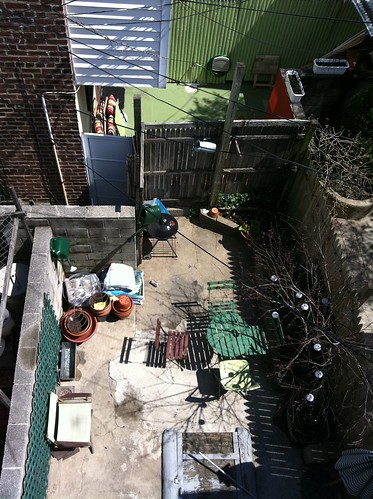 [/caption]
One of the perks of living in South Philly is that my roommate and I have a nice little patio with a built-in planter and pretty good sun. Of course my first thought was: food! A little background on me: I don't know too much about plants but my parents are avid gardeners. My father taught high school horticulture (it's totally a class) and my grandmother still has what remains of her farm, so they are my main sources for any plant-related questions. I have grown (and killed) various plants in the past, from houseplants to tomatoes, but this is my first time growing anything entirely from seed. So let's get started! I hope to learn a lot from this and hopefully you will too.
Sometime in January I started to feel my annual spring fever, so I somewhat erratically ordered a lot of seeds online. I feel like I have to come clean here and say that this is not entirely local because the seeds are from Baker Creek Heirloom Seeds. But I wanted non-genetically modified seeds and I figured heirloom varieties would be fun. That, by the way, is how I make lots of decisions. I am not a super-green-thumb or anything, but last summer I was too late to the game to start tomatoes from seed so I bought some young plants from the Lowe's on Columbus Boulevard. I doted on them, then kind of forgot about them, then overwatered them and the resulting fruit was kind of disappointing. Basically the fruit tasted...bad. It wasn't horrible but it wasn't the delicious fresh-from-the-garden taste I remembered as a kid. I chalked up some of this to possibly distorted memories and changing tastebuds, but I decided to grow things from seed the next time around to see if I couldn't get better tasting produce.
[caption id="" align="alignnone" width="374" caption="Tomato and eggplant seed packets"]
[/caption]
One of the perks of living in South Philly is that my roommate and I have a nice little patio with a built-in planter and pretty good sun. Of course my first thought was: food! A little background on me: I don't know too much about plants but my parents are avid gardeners. My father taught high school horticulture (it's totally a class) and my grandmother still has what remains of her farm, so they are my main sources for any plant-related questions. I have grown (and killed) various plants in the past, from houseplants to tomatoes, but this is my first time growing anything entirely from seed. So let's get started! I hope to learn a lot from this and hopefully you will too.
Sometime in January I started to feel my annual spring fever, so I somewhat erratically ordered a lot of seeds online. I feel like I have to come clean here and say that this is not entirely local because the seeds are from Baker Creek Heirloom Seeds. But I wanted non-genetically modified seeds and I figured heirloom varieties would be fun. That, by the way, is how I make lots of decisions. I am not a super-green-thumb or anything, but last summer I was too late to the game to start tomatoes from seed so I bought some young plants from the Lowe's on Columbus Boulevard. I doted on them, then kind of forgot about them, then overwatered them and the resulting fruit was kind of disappointing. Basically the fruit tasted...bad. It wasn't horrible but it wasn't the delicious fresh-from-the-garden taste I remembered as a kid. I chalked up some of this to possibly distorted memories and changing tastebuds, but I decided to grow things from seed the next time around to see if I couldn't get better tasting produce.
[caption id="" align="alignnone" width="374" caption="Tomato and eggplant seed packets"]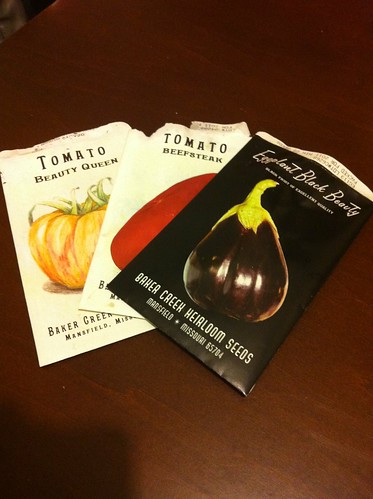 [/caption]
I started three crops inside: two varieties of tomatoes (beefsteak and an heirloom called beauty queen) and eggplant. The instructions told me to start them inside 4-6 weeks before the last frost. A quick Google search revealed that the last frost for Philadelphia is usually around the middle of April, so I started my seeds in early March. Now I know that there are seed starting kits and all sorts of special trays and planters, but I don't have that much money or space and I'd rather recycle what I already had. In our backyard there were a few pots leftover from previous tenants and I gathered a few of my own from thrift stores - I started with three, one for each crop, and then gathered more along the way. The only thing I know about pots for plants is that they should have some drainage holes in the bottom in case you are like me and tend to overwater - that way the excess water will drain out instead of flooding the plant. Some of the containers I got from thrift stores didn't have holes in the bottom but it's easy to drill little holes or, in my case, just poke some holes with a knife (be careful!) Again, going on instinct and various tips, I washed all the pots I was using with all-natural soap (Dr. Bronner's in my case) because I knew that even if I didn't quite get it all washed out it wouldn't be as horrible to the plants as a chemical-laden detergent-based soap.
The first nice sunny weekend in March I walked to the hardware store and bought two bags of potting soil. I had planned on doing a soil test of the soil that was already in my backyard but since it's all in a raised bed and I had already added potting soil to it last year I decided to skip it. Plus I am doing most of my planting in containers since a lot of the raised bed is occupied by a wonderful little Japanese maple tree which I wouldn't trade for the world but which also doesn't allow for lots of sun. So plants like tomatoes, that need full sun, will be planted in containers on the sunny side of the yard, away from the tree.
[caption id="" align="alignnone" width="375" caption="Eggplant seedlings"]
[/caption]
I started three crops inside: two varieties of tomatoes (beefsteak and an heirloom called beauty queen) and eggplant. The instructions told me to start them inside 4-6 weeks before the last frost. A quick Google search revealed that the last frost for Philadelphia is usually around the middle of April, so I started my seeds in early March. Now I know that there are seed starting kits and all sorts of special trays and planters, but I don't have that much money or space and I'd rather recycle what I already had. In our backyard there were a few pots leftover from previous tenants and I gathered a few of my own from thrift stores - I started with three, one for each crop, and then gathered more along the way. The only thing I know about pots for plants is that they should have some drainage holes in the bottom in case you are like me and tend to overwater - that way the excess water will drain out instead of flooding the plant. Some of the containers I got from thrift stores didn't have holes in the bottom but it's easy to drill little holes or, in my case, just poke some holes with a knife (be careful!) Again, going on instinct and various tips, I washed all the pots I was using with all-natural soap (Dr. Bronner's in my case) because I knew that even if I didn't quite get it all washed out it wouldn't be as horrible to the plants as a chemical-laden detergent-based soap.
The first nice sunny weekend in March I walked to the hardware store and bought two bags of potting soil. I had planned on doing a soil test of the soil that was already in my backyard but since it's all in a raised bed and I had already added potting soil to it last year I decided to skip it. Plus I am doing most of my planting in containers since a lot of the raised bed is occupied by a wonderful little Japanese maple tree which I wouldn't trade for the world but which also doesn't allow for lots of sun. So plants like tomatoes, that need full sun, will be planted in containers on the sunny side of the yard, away from the tree.
[caption id="" align="alignnone" width="375" caption="Eggplant seedlings"]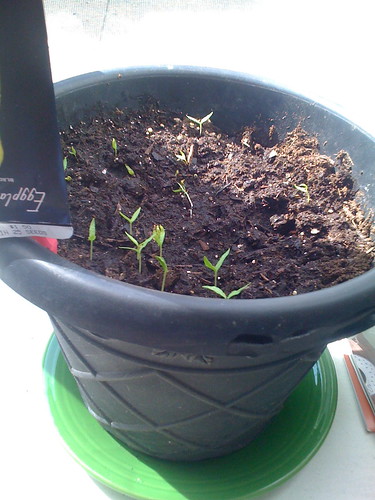 [/caption]
[caption id="" align="alignnone" width="375" caption="Beefsteak seedlings"]
[/caption]
[caption id="" align="alignnone" width="375" caption="Beefsteak seedlings"]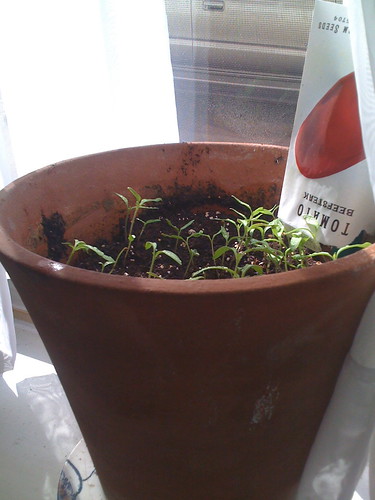 [/caption]
I basically just filled up each pot (loosely) with soil, sprinkled the seeds on top, and topped with a little more soil. Then I watered each one until water ran out the drainage holes, since when you first plant seeds the soil is very dry and seeds need water. Duh, right? Seeds also need sunlight, which can be hard to come by in a rowhouse. We get pretty good light, and it's a good idea to be aware of which way your house or plot is oriented before you start planting. Philly is kind of at an angle, by which I mean that streets going north don't actually point due north. But it's pretty close, so facing the Schuylkill is vaguely west and the Delaware is vaguely east. With that knowledge (and no compass) I've determined that my backyard is about ESE and the front of the house is therefore WNW, or something like that. Obviously if you have real person tools like a compass you can figure this out exactly. The only other note on this is that the strongest sun is from the south and the weakest from the north, so for something like tomatoes that need full sun, south sun is best. Do be careful though, because south sun in the summer in Philly can be very strong and plants will dry out very quickly (as I learned last year) and the sun can even burn the leaves if you're not careful. Sun is about amount (hours per day) and also strength, so get to know your planting space and how the sun moves through it. I am lucky to have dealt with this space last year so that I know the sunniest spots and how the sun moves according to season, but a little trial and error doesn't hurt.
With that in mind I put my three pots in the front windows, right against the glass (even though they don't need sun until they sprout) and waited, making sure to keep the soil damp. In about a week I had little beefsteak sprouts! And about a week after that the beauty queen and eggplant followed suit. Because the little seedlings were so delicate, I bought a 99 cent spray bottle so that I could mist them and not just dump water on them and knock them over. They seemed to respond well to the misting (and it was pretty fun) so I kept that up until each plant had two sets of leaves, which is when you can transplant them. I actually think it was better for me to use larger pots rather than little seedling trays since larger pots hold more dirt which holds more water and therefore doesn't require constant watering like the trays would (although a self-watering system for those would be easy to assemble and would reduce the watering work also.) Personal preference, I guess.
[caption id="" align="alignnone" width="375" caption="Beefsteaks ready to transplant"]
[/caption]
I basically just filled up each pot (loosely) with soil, sprinkled the seeds on top, and topped with a little more soil. Then I watered each one until water ran out the drainage holes, since when you first plant seeds the soil is very dry and seeds need water. Duh, right? Seeds also need sunlight, which can be hard to come by in a rowhouse. We get pretty good light, and it's a good idea to be aware of which way your house or plot is oriented before you start planting. Philly is kind of at an angle, by which I mean that streets going north don't actually point due north. But it's pretty close, so facing the Schuylkill is vaguely west and the Delaware is vaguely east. With that knowledge (and no compass) I've determined that my backyard is about ESE and the front of the house is therefore WNW, or something like that. Obviously if you have real person tools like a compass you can figure this out exactly. The only other note on this is that the strongest sun is from the south and the weakest from the north, so for something like tomatoes that need full sun, south sun is best. Do be careful though, because south sun in the summer in Philly can be very strong and plants will dry out very quickly (as I learned last year) and the sun can even burn the leaves if you're not careful. Sun is about amount (hours per day) and also strength, so get to know your planting space and how the sun moves through it. I am lucky to have dealt with this space last year so that I know the sunniest spots and how the sun moves according to season, but a little trial and error doesn't hurt.
With that in mind I put my three pots in the front windows, right against the glass (even though they don't need sun until they sprout) and waited, making sure to keep the soil damp. In about a week I had little beefsteak sprouts! And about a week after that the beauty queen and eggplant followed suit. Because the little seedlings were so delicate, I bought a 99 cent spray bottle so that I could mist them and not just dump water on them and knock them over. They seemed to respond well to the misting (and it was pretty fun) so I kept that up until each plant had two sets of leaves, which is when you can transplant them. I actually think it was better for me to use larger pots rather than little seedling trays since larger pots hold more dirt which holds more water and therefore doesn't require constant watering like the trays would (although a self-watering system for those would be easy to assemble and would reduce the watering work also.) Personal preference, I guess.
[caption id="" align="alignnone" width="375" caption="Beefsteaks ready to transplant"]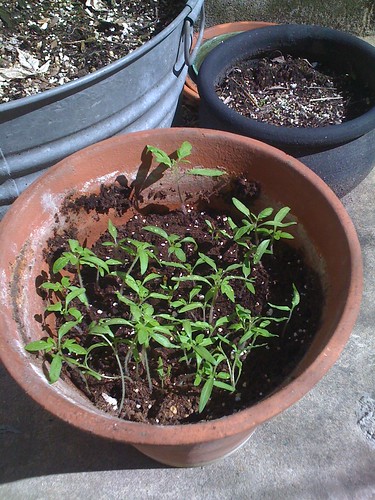 [/caption]
[caption id="" align="alignnone" width="375" caption="Beefsteak roots"]
[/caption]
[caption id="" align="alignnone" width="375" caption="Beefsteak roots"]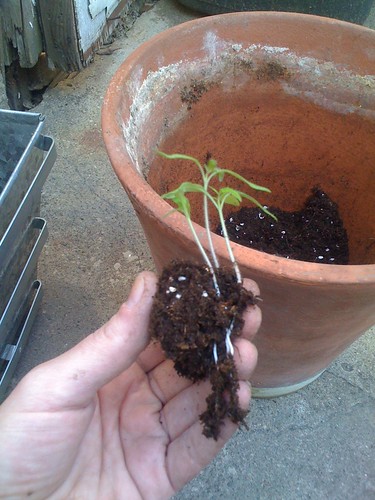 [/caption]
The last weekend in March was transplanting time for the beefsteaks, which were getting quite crowded. I gathered all my pots and two more bags of potting soil and headed outside. As I was doing this, I remembered reading (in Grid, I believe) that Green Aisle Grocery on Passyunk had local compost for $5 a bag. Now I know that you can make your own compost and that it's a great way to cut down on waste and all that, but I didn't have any started and I'm not particularly keen on worms and Green Aisle is just a short walk from my house. I rationalized that at least it was local (South Philly) compost, I was supporting a local business and it was a way to fertilize without using chemicals. A quick walk to Green Aisle and twenty minutes later I mixed some compost into the potting soil and got to work. Now this is where something like individual seedling trays would have come in handy - it was very hard to get the first few seedlings out of the pot without breaking them since they are so delicate. I ended up lifting up the top layer of the soil (the roots only went down two inches at most), setting it on the ground, and gently separating each plant by knocking the soil away from the roots and then very gently pulling the plants apart. I cannot emphasize enough how gentle I was - even just gripping the seedlings with barely any strength would have killed some of them. That said, I had so many I wasn't afraid to lose a few and got rid of the smallest ones. But seeing as how I had raised them from seed I really didn't want to just throw over half of my little babies out. I ended up saving too many (I do have limited space) but I just couldn't bear to part with them. So, more pots were gathered - thrift stores are great for this and also I found some groundspeople working at Penn and they offered me as many plastic pots as I needed from the little plants they were planting so it doesn't hurt to ask around. In the end I ended up with eight pots with anything from three to...many seedlings in them. And this is where my lack of plant knowledge comes in: two seedlings were significantly larger than the others, so I put each of those in a pot with only one smaller plant thinking that the biggest ones would be the hardiest, or at least the hardest to kill. The rest of the normal-sized ones just got a little more space. The beauty queens and the eggplants were still too small - each plant only had one or two leaves - so I just left those. I'm still not entirely sure why the beefsteaks are so much larger than the beauty queens or the eggplants, but I'm assuming that since beefsteaks are big tomatoes then the plants must be big plants. Again, some research beforehand might have been helpful but that's not really how I roll.
[caption id="" align="alignnone" width="375" caption="Newly-transplanted beefsteaks"]
[/caption]
The last weekend in March was transplanting time for the beefsteaks, which were getting quite crowded. I gathered all my pots and two more bags of potting soil and headed outside. As I was doing this, I remembered reading (in Grid, I believe) that Green Aisle Grocery on Passyunk had local compost for $5 a bag. Now I know that you can make your own compost and that it's a great way to cut down on waste and all that, but I didn't have any started and I'm not particularly keen on worms and Green Aisle is just a short walk from my house. I rationalized that at least it was local (South Philly) compost, I was supporting a local business and it was a way to fertilize without using chemicals. A quick walk to Green Aisle and twenty minutes later I mixed some compost into the potting soil and got to work. Now this is where something like individual seedling trays would have come in handy - it was very hard to get the first few seedlings out of the pot without breaking them since they are so delicate. I ended up lifting up the top layer of the soil (the roots only went down two inches at most), setting it on the ground, and gently separating each plant by knocking the soil away from the roots and then very gently pulling the plants apart. I cannot emphasize enough how gentle I was - even just gripping the seedlings with barely any strength would have killed some of them. That said, I had so many I wasn't afraid to lose a few and got rid of the smallest ones. But seeing as how I had raised them from seed I really didn't want to just throw over half of my little babies out. I ended up saving too many (I do have limited space) but I just couldn't bear to part with them. So, more pots were gathered - thrift stores are great for this and also I found some groundspeople working at Penn and they offered me as many plastic pots as I needed from the little plants they were planting so it doesn't hurt to ask around. In the end I ended up with eight pots with anything from three to...many seedlings in them. And this is where my lack of plant knowledge comes in: two seedlings were significantly larger than the others, so I put each of those in a pot with only one smaller plant thinking that the biggest ones would be the hardiest, or at least the hardest to kill. The rest of the normal-sized ones just got a little more space. The beauty queens and the eggplants were still too small - each plant only had one or two leaves - so I just left those. I'm still not entirely sure why the beefsteaks are so much larger than the beauty queens or the eggplants, but I'm assuming that since beefsteaks are big tomatoes then the plants must be big plants. Again, some research beforehand might have been helpful but that's not really how I roll.
[caption id="" align="alignnone" width="375" caption="Newly-transplanted beefsteaks"]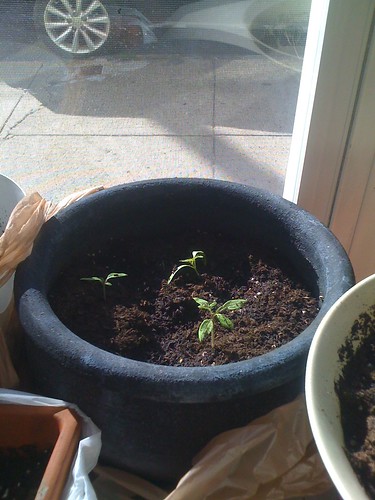 [/caption]
[caption id="" align="alignnone" width="500" caption="Front window filled with plants"]
[/caption]
[caption id="" align="alignnone" width="500" caption="Front window filled with plants"]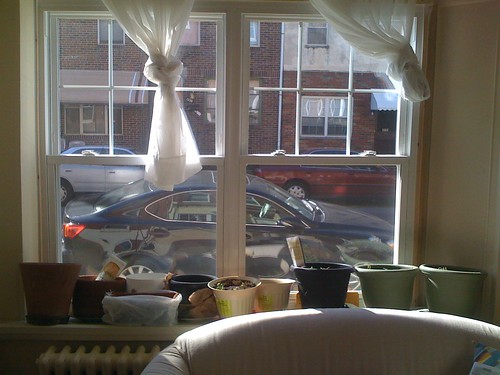 [/caption]
Fast forward a month and here we are! I'm planning to move them outside this weekend since I think we're frost-free (cross your fingers!) I'm assuming its the compost, but after transplanting the beefsteaks really took off.
[caption id="" align="alignnone" width="374" caption="Picture of beefsteaks a few weeks ago"]
[/caption]
Fast forward a month and here we are! I'm planning to move them outside this weekend since I think we're frost-free (cross your fingers!) I'm assuming its the compost, but after transplanting the beefsteaks really took off.
[caption id="" align="alignnone" width="374" caption="Picture of beefsteaks a few weeks ago"]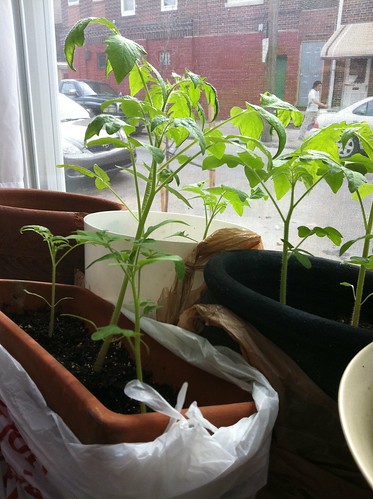 [/caption]
This past month I've switched from misting to actually watering with a watering can with one of those drip heads so that I don't just dump water on them. They got too big for the mister (heh) probably about two weeks after I transplanted them, and they needed more water. Again, I'm using fairly deep pots but with lots of sunshine I still have to water them every two days or so. (That week that was gray and rainy I only watered once or twice all week.) I'm trying really hard to stick to my grandmother's advice of watering little and often, as opposed to a lot and rarely.
I'll be back next week with another update! Also I'll be planting things directly outside, like rosemary, basil, thyme, summer squash and a few various flowers. I told you I have a lot of seeds.
Sarah DeGiorgis has lived in Philly for five years and is finally starting to feel like a true Philadelphian, though she still detests cheesesteaks. She enjoys reading, watching bad tv, eating and cooking good food and digging in the dirt.
[/caption]
This past month I've switched from misting to actually watering with a watering can with one of those drip heads so that I don't just dump water on them. They got too big for the mister (heh) probably about two weeks after I transplanted them, and they needed more water. Again, I'm using fairly deep pots but with lots of sunshine I still have to water them every two days or so. (That week that was gray and rainy I only watered once or twice all week.) I'm trying really hard to stick to my grandmother's advice of watering little and often, as opposed to a lot and rarely.
I'll be back next week with another update! Also I'll be planting things directly outside, like rosemary, basil, thyme, summer squash and a few various flowers. I told you I have a lot of seeds.
Sarah DeGiorgis has lived in Philly for five years and is finally starting to feel like a true Philadelphian, though she still detests cheesesteaks. She enjoys reading, watching bad tv, eating and cooking good food and digging in the dirt.
 [/caption]
One of the perks of living in South Philly is that my roommate and I have a nice little patio with a built-in planter and pretty good sun. Of course my first thought was: food! A little background on me: I don't know too much about plants but my parents are avid gardeners. My father taught high school horticulture (it's totally a class) and my grandmother still has what remains of her farm, so they are my main sources for any plant-related questions. I have grown (and killed) various plants in the past, from houseplants to tomatoes, but this is my first time growing anything entirely from seed. So let's get started! I hope to learn a lot from this and hopefully you will too.
Sometime in January I started to feel my annual spring fever, so I somewhat erratically ordered a lot of seeds online. I feel like I have to come clean here and say that this is not entirely local because the seeds are from Baker Creek Heirloom Seeds. But I wanted non-genetically modified seeds and I figured heirloom varieties would be fun. That, by the way, is how I make lots of decisions. I am not a super-green-thumb or anything, but last summer I was too late to the game to start tomatoes from seed so I bought some young plants from the Lowe's on Columbus Boulevard. I doted on them, then kind of forgot about them, then overwatered them and the resulting fruit was kind of disappointing. Basically the fruit tasted...bad. It wasn't horrible but it wasn't the delicious fresh-from-the-garden taste I remembered as a kid. I chalked up some of this to possibly distorted memories and changing tastebuds, but I decided to grow things from seed the next time around to see if I couldn't get better tasting produce.
[caption id="" align="alignnone" width="374" caption="Tomato and eggplant seed packets"]
[/caption]
One of the perks of living in South Philly is that my roommate and I have a nice little patio with a built-in planter and pretty good sun. Of course my first thought was: food! A little background on me: I don't know too much about plants but my parents are avid gardeners. My father taught high school horticulture (it's totally a class) and my grandmother still has what remains of her farm, so they are my main sources for any plant-related questions. I have grown (and killed) various plants in the past, from houseplants to tomatoes, but this is my first time growing anything entirely from seed. So let's get started! I hope to learn a lot from this and hopefully you will too.
Sometime in January I started to feel my annual spring fever, so I somewhat erratically ordered a lot of seeds online. I feel like I have to come clean here and say that this is not entirely local because the seeds are from Baker Creek Heirloom Seeds. But I wanted non-genetically modified seeds and I figured heirloom varieties would be fun. That, by the way, is how I make lots of decisions. I am not a super-green-thumb or anything, but last summer I was too late to the game to start tomatoes from seed so I bought some young plants from the Lowe's on Columbus Boulevard. I doted on them, then kind of forgot about them, then overwatered them and the resulting fruit was kind of disappointing. Basically the fruit tasted...bad. It wasn't horrible but it wasn't the delicious fresh-from-the-garden taste I remembered as a kid. I chalked up some of this to possibly distorted memories and changing tastebuds, but I decided to grow things from seed the next time around to see if I couldn't get better tasting produce.
[caption id="" align="alignnone" width="374" caption="Tomato and eggplant seed packets"] [/caption]
I started three crops inside: two varieties of tomatoes (beefsteak and an heirloom called beauty queen) and eggplant. The instructions told me to start them inside 4-6 weeks before the last frost. A quick Google search revealed that the last frost for Philadelphia is usually around the middle of April, so I started my seeds in early March. Now I know that there are seed starting kits and all sorts of special trays and planters, but I don't have that much money or space and I'd rather recycle what I already had. In our backyard there were a few pots leftover from previous tenants and I gathered a few of my own from thrift stores - I started with three, one for each crop, and then gathered more along the way. The only thing I know about pots for plants is that they should have some drainage holes in the bottom in case you are like me and tend to overwater - that way the excess water will drain out instead of flooding the plant. Some of the containers I got from thrift stores didn't have holes in the bottom but it's easy to drill little holes or, in my case, just poke some holes with a knife (be careful!) Again, going on instinct and various tips, I washed all the pots I was using with all-natural soap (Dr. Bronner's in my case) because I knew that even if I didn't quite get it all washed out it wouldn't be as horrible to the plants as a chemical-laden detergent-based soap.
The first nice sunny weekend in March I walked to the hardware store and bought two bags of potting soil. I had planned on doing a soil test of the soil that was already in my backyard but since it's all in a raised bed and I had already added potting soil to it last year I decided to skip it. Plus I am doing most of my planting in containers since a lot of the raised bed is occupied by a wonderful little Japanese maple tree which I wouldn't trade for the world but which also doesn't allow for lots of sun. So plants like tomatoes, that need full sun, will be planted in containers on the sunny side of the yard, away from the tree.
[caption id="" align="alignnone" width="375" caption="Eggplant seedlings"]
[/caption]
I started three crops inside: two varieties of tomatoes (beefsteak and an heirloom called beauty queen) and eggplant. The instructions told me to start them inside 4-6 weeks before the last frost. A quick Google search revealed that the last frost for Philadelphia is usually around the middle of April, so I started my seeds in early March. Now I know that there are seed starting kits and all sorts of special trays and planters, but I don't have that much money or space and I'd rather recycle what I already had. In our backyard there were a few pots leftover from previous tenants and I gathered a few of my own from thrift stores - I started with three, one for each crop, and then gathered more along the way. The only thing I know about pots for plants is that they should have some drainage holes in the bottom in case you are like me and tend to overwater - that way the excess water will drain out instead of flooding the plant. Some of the containers I got from thrift stores didn't have holes in the bottom but it's easy to drill little holes or, in my case, just poke some holes with a knife (be careful!) Again, going on instinct and various tips, I washed all the pots I was using with all-natural soap (Dr. Bronner's in my case) because I knew that even if I didn't quite get it all washed out it wouldn't be as horrible to the plants as a chemical-laden detergent-based soap.
The first nice sunny weekend in March I walked to the hardware store and bought two bags of potting soil. I had planned on doing a soil test of the soil that was already in my backyard but since it's all in a raised bed and I had already added potting soil to it last year I decided to skip it. Plus I am doing most of my planting in containers since a lot of the raised bed is occupied by a wonderful little Japanese maple tree which I wouldn't trade for the world but which also doesn't allow for lots of sun. So plants like tomatoes, that need full sun, will be planted in containers on the sunny side of the yard, away from the tree.
[caption id="" align="alignnone" width="375" caption="Eggplant seedlings"] [/caption]
[caption id="" align="alignnone" width="375" caption="Beefsteak seedlings"]
[/caption]
[caption id="" align="alignnone" width="375" caption="Beefsteak seedlings"] [/caption]
I basically just filled up each pot (loosely) with soil, sprinkled the seeds on top, and topped with a little more soil. Then I watered each one until water ran out the drainage holes, since when you first plant seeds the soil is very dry and seeds need water. Duh, right? Seeds also need sunlight, which can be hard to come by in a rowhouse. We get pretty good light, and it's a good idea to be aware of which way your house or plot is oriented before you start planting. Philly is kind of at an angle, by which I mean that streets going north don't actually point due north. But it's pretty close, so facing the Schuylkill is vaguely west and the Delaware is vaguely east. With that knowledge (and no compass) I've determined that my backyard is about ESE and the front of the house is therefore WNW, or something like that. Obviously if you have real person tools like a compass you can figure this out exactly. The only other note on this is that the strongest sun is from the south and the weakest from the north, so for something like tomatoes that need full sun, south sun is best. Do be careful though, because south sun in the summer in Philly can be very strong and plants will dry out very quickly (as I learned last year) and the sun can even burn the leaves if you're not careful. Sun is about amount (hours per day) and also strength, so get to know your planting space and how the sun moves through it. I am lucky to have dealt with this space last year so that I know the sunniest spots and how the sun moves according to season, but a little trial and error doesn't hurt.
With that in mind I put my three pots in the front windows, right against the glass (even though they don't need sun until they sprout) and waited, making sure to keep the soil damp. In about a week I had little beefsteak sprouts! And about a week after that the beauty queen and eggplant followed suit. Because the little seedlings were so delicate, I bought a 99 cent spray bottle so that I could mist them and not just dump water on them and knock them over. They seemed to respond well to the misting (and it was pretty fun) so I kept that up until each plant had two sets of leaves, which is when you can transplant them. I actually think it was better for me to use larger pots rather than little seedling trays since larger pots hold more dirt which holds more water and therefore doesn't require constant watering like the trays would (although a self-watering system for those would be easy to assemble and would reduce the watering work also.) Personal preference, I guess.
[caption id="" align="alignnone" width="375" caption="Beefsteaks ready to transplant"]
[/caption]
I basically just filled up each pot (loosely) with soil, sprinkled the seeds on top, and topped with a little more soil. Then I watered each one until water ran out the drainage holes, since when you first plant seeds the soil is very dry and seeds need water. Duh, right? Seeds also need sunlight, which can be hard to come by in a rowhouse. We get pretty good light, and it's a good idea to be aware of which way your house or plot is oriented before you start planting. Philly is kind of at an angle, by which I mean that streets going north don't actually point due north. But it's pretty close, so facing the Schuylkill is vaguely west and the Delaware is vaguely east. With that knowledge (and no compass) I've determined that my backyard is about ESE and the front of the house is therefore WNW, or something like that. Obviously if you have real person tools like a compass you can figure this out exactly. The only other note on this is that the strongest sun is from the south and the weakest from the north, so for something like tomatoes that need full sun, south sun is best. Do be careful though, because south sun in the summer in Philly can be very strong and plants will dry out very quickly (as I learned last year) and the sun can even burn the leaves if you're not careful. Sun is about amount (hours per day) and also strength, so get to know your planting space and how the sun moves through it. I am lucky to have dealt with this space last year so that I know the sunniest spots and how the sun moves according to season, but a little trial and error doesn't hurt.
With that in mind I put my three pots in the front windows, right against the glass (even though they don't need sun until they sprout) and waited, making sure to keep the soil damp. In about a week I had little beefsteak sprouts! And about a week after that the beauty queen and eggplant followed suit. Because the little seedlings were so delicate, I bought a 99 cent spray bottle so that I could mist them and not just dump water on them and knock them over. They seemed to respond well to the misting (and it was pretty fun) so I kept that up until each plant had two sets of leaves, which is when you can transplant them. I actually think it was better for me to use larger pots rather than little seedling trays since larger pots hold more dirt which holds more water and therefore doesn't require constant watering like the trays would (although a self-watering system for those would be easy to assemble and would reduce the watering work also.) Personal preference, I guess.
[caption id="" align="alignnone" width="375" caption="Beefsteaks ready to transplant"] [/caption]
[caption id="" align="alignnone" width="375" caption="Beefsteak roots"]
[/caption]
[caption id="" align="alignnone" width="375" caption="Beefsteak roots"] [/caption]
The last weekend in March was transplanting time for the beefsteaks, which were getting quite crowded. I gathered all my pots and two more bags of potting soil and headed outside. As I was doing this, I remembered reading (in Grid, I believe) that Green Aisle Grocery on Passyunk had local compost for $5 a bag. Now I know that you can make your own compost and that it's a great way to cut down on waste and all that, but I didn't have any started and I'm not particularly keen on worms and Green Aisle is just a short walk from my house. I rationalized that at least it was local (South Philly) compost, I was supporting a local business and it was a way to fertilize without using chemicals. A quick walk to Green Aisle and twenty minutes later I mixed some compost into the potting soil and got to work. Now this is where something like individual seedling trays would have come in handy - it was very hard to get the first few seedlings out of the pot without breaking them since they are so delicate. I ended up lifting up the top layer of the soil (the roots only went down two inches at most), setting it on the ground, and gently separating each plant by knocking the soil away from the roots and then very gently pulling the plants apart. I cannot emphasize enough how gentle I was - even just gripping the seedlings with barely any strength would have killed some of them. That said, I had so many I wasn't afraid to lose a few and got rid of the smallest ones. But seeing as how I had raised them from seed I really didn't want to just throw over half of my little babies out. I ended up saving too many (I do have limited space) but I just couldn't bear to part with them. So, more pots were gathered - thrift stores are great for this and also I found some groundspeople working at Penn and they offered me as many plastic pots as I needed from the little plants they were planting so it doesn't hurt to ask around. In the end I ended up with eight pots with anything from three to...many seedlings in them. And this is where my lack of plant knowledge comes in: two seedlings were significantly larger than the others, so I put each of those in a pot with only one smaller plant thinking that the biggest ones would be the hardiest, or at least the hardest to kill. The rest of the normal-sized ones just got a little more space. The beauty queens and the eggplants were still too small - each plant only had one or two leaves - so I just left those. I'm still not entirely sure why the beefsteaks are so much larger than the beauty queens or the eggplants, but I'm assuming that since beefsteaks are big tomatoes then the plants must be big plants. Again, some research beforehand might have been helpful but that's not really how I roll.
[caption id="" align="alignnone" width="375" caption="Newly-transplanted beefsteaks"]
[/caption]
The last weekend in March was transplanting time for the beefsteaks, which were getting quite crowded. I gathered all my pots and two more bags of potting soil and headed outside. As I was doing this, I remembered reading (in Grid, I believe) that Green Aisle Grocery on Passyunk had local compost for $5 a bag. Now I know that you can make your own compost and that it's a great way to cut down on waste and all that, but I didn't have any started and I'm not particularly keen on worms and Green Aisle is just a short walk from my house. I rationalized that at least it was local (South Philly) compost, I was supporting a local business and it was a way to fertilize without using chemicals. A quick walk to Green Aisle and twenty minutes later I mixed some compost into the potting soil and got to work. Now this is where something like individual seedling trays would have come in handy - it was very hard to get the first few seedlings out of the pot without breaking them since they are so delicate. I ended up lifting up the top layer of the soil (the roots only went down two inches at most), setting it on the ground, and gently separating each plant by knocking the soil away from the roots and then very gently pulling the plants apart. I cannot emphasize enough how gentle I was - even just gripping the seedlings with barely any strength would have killed some of them. That said, I had so many I wasn't afraid to lose a few and got rid of the smallest ones. But seeing as how I had raised them from seed I really didn't want to just throw over half of my little babies out. I ended up saving too many (I do have limited space) but I just couldn't bear to part with them. So, more pots were gathered - thrift stores are great for this and also I found some groundspeople working at Penn and they offered me as many plastic pots as I needed from the little plants they were planting so it doesn't hurt to ask around. In the end I ended up with eight pots with anything from three to...many seedlings in them. And this is where my lack of plant knowledge comes in: two seedlings were significantly larger than the others, so I put each of those in a pot with only one smaller plant thinking that the biggest ones would be the hardiest, or at least the hardest to kill. The rest of the normal-sized ones just got a little more space. The beauty queens and the eggplants were still too small - each plant only had one or two leaves - so I just left those. I'm still not entirely sure why the beefsteaks are so much larger than the beauty queens or the eggplants, but I'm assuming that since beefsteaks are big tomatoes then the plants must be big plants. Again, some research beforehand might have been helpful but that's not really how I roll.
[caption id="" align="alignnone" width="375" caption="Newly-transplanted beefsteaks"] [/caption]
[caption id="" align="alignnone" width="500" caption="Front window filled with plants"]
[/caption]
[caption id="" align="alignnone" width="500" caption="Front window filled with plants"] [/caption]
Fast forward a month and here we are! I'm planning to move them outside this weekend since I think we're frost-free (cross your fingers!) I'm assuming its the compost, but after transplanting the beefsteaks really took off.
[caption id="" align="alignnone" width="374" caption="Picture of beefsteaks a few weeks ago"]
[/caption]
Fast forward a month and here we are! I'm planning to move them outside this weekend since I think we're frost-free (cross your fingers!) I'm assuming its the compost, but after transplanting the beefsteaks really took off.
[caption id="" align="alignnone" width="374" caption="Picture of beefsteaks a few weeks ago"] [/caption]
This past month I've switched from misting to actually watering with a watering can with one of those drip heads so that I don't just dump water on them. They got too big for the mister (heh) probably about two weeks after I transplanted them, and they needed more water. Again, I'm using fairly deep pots but with lots of sunshine I still have to water them every two days or so. (That week that was gray and rainy I only watered once or twice all week.) I'm trying really hard to stick to my grandmother's advice of watering little and often, as opposed to a lot and rarely.
I'll be back next week with another update! Also I'll be planting things directly outside, like rosemary, basil, thyme, summer squash and a few various flowers. I told you I have a lot of seeds.
Sarah DeGiorgis has lived in Philly for five years and is finally starting to feel like a true Philadelphian, though she still detests cheesesteaks. She enjoys reading, watching bad tv, eating and cooking good food and digging in the dirt.
[/caption]
This past month I've switched from misting to actually watering with a watering can with one of those drip heads so that I don't just dump water on them. They got too big for the mister (heh) probably about two weeks after I transplanted them, and they needed more water. Again, I'm using fairly deep pots but with lots of sunshine I still have to water them every two days or so. (That week that was gray and rainy I only watered once or twice all week.) I'm trying really hard to stick to my grandmother's advice of watering little and often, as opposed to a lot and rarely.
I'll be back next week with another update! Also I'll be planting things directly outside, like rosemary, basil, thyme, summer squash and a few various flowers. I told you I have a lot of seeds.
Sarah DeGiorgis has lived in Philly for five years and is finally starting to feel like a true Philadelphian, though she still detests cheesesteaks. She enjoys reading, watching bad tv, eating and cooking good food and digging in the dirt.
